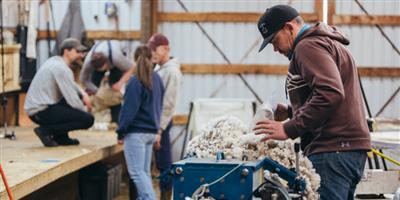by Marshall Swearingen, MSU News Service
On March 16, as about 200 sheep from Montana State University’s research flock were relieved of their annual wool fleece, a new, one-of-a-kind machine designed by MSU’s Montana Manufacturing Extension Center was put through its paces.
Unlike other, older machines used to assess the quality of wool, the one designed by MMEC is faster and portable, said Whit Stewart, a sheep specialist with MSU Extension and an assistant professor of sheep and wool production in the Department of Animal and Range Sciences in MSU’s College of Agriculture.
By allowing his team to quickly and efficiently take wool samples on-site, the machine is increasing the team’s capacity for identifying sheep that yield quality wool, which could help Montana sheep producers breed for higher profits, Stewart said.
In the past, Stewart’s research team would haul entire fleeces, rather than small samples, to the MSU Wool Lab at the Bozeman campus in order to use a slower, stationary machine built in the 1940s.
“It used to take half an hour to sample a fleece, compared to just a couple minutes now,” he said.
As rain pattered on the roof of the sheep barn at MSU’s Red Bluff Research Ranch near Norris, shearers stooped to buzz the thick, white coats from each of the yearling ewes, then tossed the fleeces to MSU Wool Lab manager Andrew Williams.
Williams placed each one into the machine’s filing drawer-sized box made of heavy-gauge metal. At the press of a lever, powerful hydraulics rammed a grid of 16 hollow spikes into the box, sending “core” samples of wool onto a tray below.
Taking multiple cores from each fleece ensures accurate sampling, said Wes Helle, a sophomore majoring in range science and a research assistant with MSU Extension’s sheep program. He helped Williams collect the samples into
Back at the MSU Wool Lab, the samples would be weighed,
“You want to have high-yielding, uniform fleece to get the best profit from your wool crop,” Williams said.
The data from the MSU research flock are registered with the National Sheep Improvement Program, which maintains a database of sheep genetics that producers reference for breeding sheep for wool quality and other characteristics, Stewart said.
Many of the sheep breeds being raised in Montana were developed half a century ago, and since then, research about wool yield has stagnated, in large part because of the logistical challenges of sampling wool from large numbers of sheep, according to Stewart. That’s why he approached MMEC about a year ago and asked for help.
“I knew they were a resource that I could turn to,” Stewart said of MMEC, which is housed in MSU’s College of Engineering and supports manufacturing in the state through various forms of outreach and assistance.
MMEC director Paddy Fleming said he and his colleagues enjoyed the engineering challenge of designing the machine. Former MMEC engineer Rob Cook, who graduated from MSU’s College of Engineering in 1988, was the primary designer. MMEC selected
According to Fleming, other land-grant universities have expressed interest in the machine, which could translate to business for Gerbers.
Prior to the MSU
The MSU Wool Lab is one of only two wool research facilities at land-grant universities in the U.S. According to Stewart, MSU Extension hopes to leverage the wool-testing machine’s capacity into providing increased assistance to Montana wool growers.
“We took our knowledge of animal husbandry and wool, and combined it with MMEC’s engineering expertise, to make a unit that allows us to do research that needs to be done,” he said.
Contact: Whit Stewart, whit.stewart1@montana.edu, (406) 994-3758; Paddy Fleming, pfleming@montana.edu, (406) 994-3812.
Andrew Williams, Wool Lab manager at Montana State University tests wool fleece from Targhee-Rambouillet


